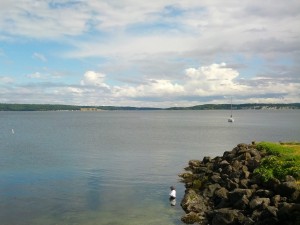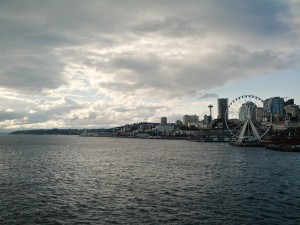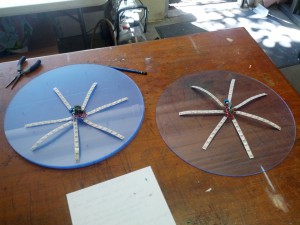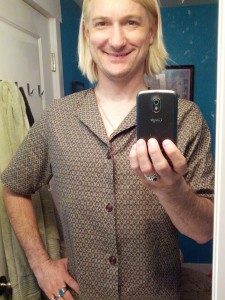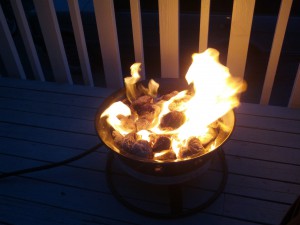
This propane burner holds a pile of rocks, diffusing what would normally be a simple blue flame into a big wispy orange flame like a traditional campfire. I have a perfectly serviceable firepit at home, but this portable burner will be great for festivals and camping in areas with burn bans, where it would be important not to leave a bunch of ash or create flying sparks.
June 28, 2014
June 27, 2014
New propane fire pit
June 26, 2014
Motorcycle ride around Mount Rainier
SoundRider has an article describing a trip around Mount Rainier which sounds like it would be fun.
I couldn’t imagine it without a map, so I plugged all the place-names into Google Maps and here’s what it looks like.
June 24, 2014
Eva’s big Flowerz sculptures from 2010 have been dragged out to Burning Man and to dozens of other events around Seattle over the last four years, and they’ve definitely taken a beating. My original electronics design was intended for a single, permanent indoor setup, so I’m surprised the lights survived being taken down and put back up in all kinds of environments as well as they have. They’ve gotten increasingly cranky, though, and now that half of them have died it’s definitely time for a replacement set.
LED and controller technology have come a long way since I designed the original lights. The new hardware is simpler, cheaper, and much more sophisticated; the new lights will have four times as many addressable pixels, so the animation space will now be two-dimensional (in polar coordinates) and not just a one-dimensional ring. What’s more, I had to individually hand-solder over a thousand through-hole LEDs for the old lights – there were dozens of tiny little wires running every which way. With the new system, the LEDs come mounted on strips of tape, all bussed up, so one control wire and two power wires are enough for eight RGB pixels. It’s AMAZING.
Stefan S. has been helping out with this project, and in just a couple nights of work we’ve finished all the soldering for two of the lights, with a lot of progress made on the other four. One more work session will finish the job. This is… I don’t remember exactly how many hours I spent on the originals, but it was in a whole different order of magnitude.
It’s a little bittersweet, opening up the old flower lights, tearing out what are now hilariously clunky, awkward, inefficient electronic devices that were nevertheless the very best I could do at the time, and replacing them with a project so simple it feels like cheating… but really, the hardware was always just a display for the animation algorithm, and that’s still the bit where the Artâ„¢ comes in.
June 23, 2014
Simple summer shirt design, take 5
I made some more tweaks to the simple summer shirt pattern: rounded the armscye, tapered the sleeve, added a topstitched French placket, and lengthened the hem. I mismeasured the placket width and made this shirt a little too blousy but I’ve taken the pattern in so the next one will be better. This particular shirt also has lapel facings, but that detail is too fiddly to qualify as “simple”. I think I’ll reserve this design for fabrics which don’t have a clearly “wrong” side, then work up a variant with a banded collar which will work better for prints and the like.
June 22, 2014
June 20, 2014
Electric Harley?
Harley-Davidson‘s entire brand image is built on nostalgia; their reputation for low-quality engineering is the subject of endless biker jokes. Harleys, the non-Harley-rider will tell you, are expensive, unreliable, old-fashioned bikes for people who care more about style than substance. H-D is literally the last motorcycle manufacturer I would expect to announce an electric motorcycle project. There are no specs, there is no timeline, there is no actual product, just a prototype – but it’s a damn cool prototype and an amazing statement from the one company I’d most expect to be flogging noisy, stinky, unreliable gas-burners decades after everyone else on the highway has switched over to electricity.
My plan, of course, is to buy an electric bike as soon as I can afford one; bikes with enough range to satisfy my everyday needs have been out for a few years now. I’ll keep a big, heavy, luggage-equipped gasoline-powered bike around for road trips, but a svelte, zippy, quiet electric seems like the perfect machine for getting around the city.
Looking toward Tesla and its network of superchargers, though, it’s not hard to imagine a not-too-distant future where cross-country electric motorcycle road trips could be totally practical. For car drivers, the idea of stopping for an hour’s break every couple hundred miles to recharge sounds just barely acceptable, but that’s basically what non-Iron-Butt motorcycle riders do on road trips already. Riding is a lot more tiring than driving; you need time to stretch and rest. What’s more, you can’t use the drive-through; you have to stop for a while when it’s time to eat.
Further, an electric motorcycle’s battery pack is always going to be a lot smaller than an electric car’s, and the bike is going to get a lot more distance per kilogram than the car will, so a hypothetical half-hour break at a Tesla-style supercharger could potentially give your electric bike more extra range miles than your body can take before its next rest.
The problem, of course, is that Tesla is sensibly building their superchargers along major highways, the kinds of big-slab roads motorcyclists tend to avoid; a hypothetical Supercharger-compatible motorcycle might be capable of doing a long road trip, but it might not be the kind of road trip you’d actually want to take.
Harley should license Tesla’s supercharger technology for their electric bikes, then identify the nation’s best two-lane highways, the motorcycle roads everyone wants to ride, and they should build their own supercharger stations in the small towns at either end. I’m thinking of roads like CA 299, the Blue Ridge Highway, and the Cascades Loop. Estimates I’ve read suggest that Tesla’s supercharger stations cost about $100k-$175k; for about half a million bucks, then, Harley could open up the entire Cascade Loop to electric motorcycle riders.
The awesome part is that this is either feasible or very close to feasible with current technology, and once you get past the “electric” hurdle, it actually fits right in with Harley’s market. Brammo’s Empulse has a 10k battery pack, a highway range around 60 miles, a top speed of 110 mph, and a Level-2 top-up charge time of 2 hours… but Harley customers are already happy to pay lots of money for relatively big, heavy, slow bikes, just because they look cool, feel comfortable on long road trips, and have lots of torque. Electric bikes already come with huge amounts of torque – so Harley should just stack that sucker up with a really big battery pack, forget about the top speed, set their designers to work making it look cool, and then give people their road trip kicks by rolling out a network of Level-3 fast chargers.
They will make MILLIONS, and they’ll bring electric vehicle tech to places it would never otherwise go in the process.
June 14, 2014
I just ordered a full set of body armor inserts for my motorcycle jacket. I can’t really afford it right now, but it feels important. I’ll make it work.
June 7, 2014
Eulogy for John Mullally
John Mullally is one of the first people I met when I moved to Seattle, through the Monday night pool group at The Garage. I don’t remember hitting it off in any particularly special way at first, but we kept on hanging out, drinking, chatting, and playing pool every week. My affection and respect for him steadily grew, and as time went by he became one of my closest friends. Our lives have converged and diverged over the years, as lives tend to do, but as I think back over the fourteen years of our friendship, it’s hard to remember very many weeks in which we didn’t talk or spend at least a bit of time together.
I went through thousands of photos of John over the past week, preparing a slideshow for this memorial service. It’s been interesting to see all these other parts of his life – extended family, other circles of friends, his career, all of his various adventures. What struck me most is just how consistent these photos are with my own memories of John. He’s always smiling, always spending time with people he cares about, always exploring remote and beautiful places. Whether he’s spiffed up and looking sharp, or goofing off in some ridiculous costume, he always seems like he is completely at home in his own skin.
John was loved by a huge array of friends, old and new. He worked hard, built an excellent career, and earned the full respect of his peers. He adored his family and was fortunate enough to be able to spend lots of quality time with his daughters. His wife loved him with all her heart, and made sure he knew it. He had outlets for his creative impulses. He was one of the steadiest, happiest people I have ever known. He lived a really good life.
I rode my motorcycle over to John & Holly’s place last October for an evening of smoking and drinking and cards. Someone waiting at a cross street didn’t see me coming and pulled out into the road, directly across my path. I reacted quickly and managed not to hit the car, but I lost control in the process and went tumbling down the road. So much for cards and whiskey – I spent most of the night in the ER. I’m okay, and I’ll make a full recovery, but six months later the broken bones in my hand are still healing. If any element of the timing that night had changed even slightly, the outcome might have been very different. I could have been paralyzed, or crippled, or killed – or I might not have been injured at all, and wouldn’t have this story to tell.
John and Holly put me up in their spare room that night, and drove me home the next day. It was good to have friends ready to take care of me.
A couple of people asked, while I was recuperating, whether this meant I was done riding. The question surprised me, but it got me thinking about risk, and about how I’ve chosen to manage risk in my life. “Now that you’ve come this close to disaster,” the question implied, “does that change the way you feel about the risk you’re taking?”
I always knew there was a chance that I might be injured or even killed in a motorcycle crash. I chose to accept the risk, because I get so much joy from riding. I feel alive, my mind feels clear, I feel light and free; it’s hard to put this into words without sounding a bit ridiculous, but I’m always happier when I’ve been riding.
I do whatever I can to mitigate the risk I’m taking. I got professional rider training, I bought high-quality safety gear and I always wear it, I keep my bike maintained in good working order, and when I’m riding I pay constant attention to my surroundings. Regardless, I am choosing to accept the possibility of injury or death every time I get on the bike. I was unlucky that day a few months ago, but that event doesn’t change the nature of the risk involved or the fundamental values informing my choice. I will keep on riding because it’s part of the life I want to live. I accept the risk as part of the price of the good fulfilling life I want to have.
John and I talked about mountaineering often. I never had his dedication, or anything like his level of skill, but I’ve been hiking and climbing my whole life, and I understood where he was coming from when he talked about high altitudes and dangerous glaciers. He knew exactly what he was doing. He knew how dangerous it could be, and he knew what he was risking by doing it. But he also approached mountaineering with the utmost care and responsibility. He was constantly learning, practicing, and training. He hired the best guides he could find and he had great respect for their advice. He employed all the resources he had to mitigate the risks he was taking; he was the most skillful, responsible, clear-headed mountaineer I’ve ever met.
Still, he chose to accept the risk, because it was part of the price of living his good life. It was part of being true to himself and to the dreams that drove him forward. As I looked through all the pictures in the slideshow, I saw photo after photo of John out in high, wild, beautiful places, pushing himself hard, seeing amazing sights, sharing intense experiences with people he respected and trusted. In these pictures, he’s always smiling; over and over, he’s smiling and happy. He loved this experience. It is utterly clear that climbing was a key piece of that rich, fulfilled, happy life he lived.
It’s tragic that he is gone. I wish it were otherwise. But honestly, if I could go back in time, would I tell him not to go climb Liberty Ridge? I couldn’t. He didn’t make that climb on a whim. It was no flight of fancy. It was an inevitable part of the long arc of his life, a choice he made with eyes wide open, one in a long line of similar choices he had been making over and over throughout his life. Climbing was a fundamental piece of the brilliant, joyful, loving, rich life he was fortunate enough to live, and we, his friends and family, were fortunate enough to share. John wouldn’t have been John without it.
So here we are: I wish he could have had decades more of joy and love, more mountains, more glaciers, more time with his family, more time with his friends. I’m going to miss sitting around the campfire with him, talking about whatever. I’m going to miss trash-talking over our games of cards. I’m going to miss his goofball sincerity, his constant undercurrent of happiness. And wow, am I going to miss his amazing cooking. But I am glad that he got to have that life. I am glad that he lived a life that was true to himself and to everyone around him. I am glad that he was exactly who he was. And I am glad that I had the chance to call him my friend.
June 2, 2014
John Mullally was a good friend of mine. He died last week while climbing Mt. Rainier. It’s been a strange couple of days absorbing that.

